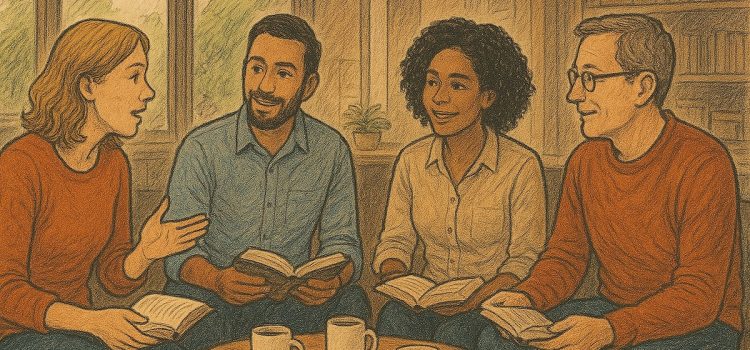
We’ve put together discussion questions for Just Mercy by Bryan Stevenson that you can use with a book club, a class at school, or a team at work. We include sample answers, book club activities that will help you get more out of what you’ve read, and recommendations for more reading if you like this book.
Table of Contents
Book Synopsis
Just Mercy is Bryan Stevenson’s memoir about his career as a young lawyer defending those most desperate and in need—the poor, the wrongly condemned, and women and children trapped in the farthest reaches of the criminal justice system. The book centers on Walter McMillian, a Black man sentenced to death in Alabama for the murder of a white woman, despite compelling evidence of his innocence and the testimony of multiple witnesses placing him elsewhere at the time of the crime.
Through McMillian’s case and others, Stevenson exposes racism, corruption, and inequality in America’s justice system. He recounts his fight to free Walter and dozens of other wrongly convicted prisoners, while also founding the Equal Justice Initiative to provide legal representation to marginalized communities. The book is a powerful indictment of mass incarceration and the death penalty, and it’s an inspiring testament to the importance of mercy, compassion, and fighting for justice even when the odds seem insurmountable.
Read Shortform’s comprehensive guide to this book.
Just Mercy Discussion Questions & Sample Answers
Along with discussion questions for Just Mercy, we include sample answers you can use as prompts.
- What does the title “Just Mercy” mean, and how does it relate to the themes of the book?
- Sample answer: I think the title works on multiple levels. On one hand, it’s about justice and mercy—two concepts that Stevenson argues should go together but often don’t in our legal system. But I also read “just” as meaning “only” or “simply,” like all we need is mercy. Throughout the book, Stevenson shows how the system is so harsh and unforgiving (especially to the poor and minorities), and he’s making the case that we need to lead with compassion and understanding rather than punishment.
- How does Stevenson’s first-person narrative style affect your reading experience and connection to the material?
- Sample answer: I found his voice really compelling because it felt so honest and personal. He doesn’t try to be a detached observer; he shares his own fears, doubts, and emotional reactions to these cases. When he talks about being terrified during his first death row visit or feeling devastated when he loses a case, it made the stories feel more real to me. It’s not just about legal arguments; it’s about human beings trying to help other human beings.
- What was your reaction to Walter McMillian’s case and the circumstances of his conviction?
- Sample answer: I was absolutely shocked, honestly. The fact that he was convicted despite having so many witnesses who could account for his whereabouts, and that the main testimony came from a career criminal who was obviously coerced—it’s terrifying. What really got me was how the community knew he was innocent, but the system just steamrolled right over the truth because it was convenient. It made me wonder how many other Walter McMillians are out there.
- How does Stevenson portray the intersection of race and justice in America?
- Sample answer: He doesn’t pull any punches about how racism is baked into the system. From the history of slavery and lynching to modern-day mass incarceration, he draws a direct line showing how racial bias has always been part of American justice. The statistics he shares about sentencing disparities are damning, but what really drove it home for me were the individual stories—like how Walter’s relationship with a white woman seemed to be the real “crime” that motivated his prosecution.
- What role does poverty play in the injustices Stevenson describes?
- Sample answer: Poverty is almost as important as race in this book. Stevenson points out again and again that poor people can’t afford good lawyers, so they end up with overworked public defenders or incompetent court-appointed attorneys. They can’t make bail, so they sit in jail even when they’re innocent. They don’t have the resources to investigate their own cases or hire expert witnesses. It’s like the system is designed to punish people for being poor, which seems fundamentally wrong in a country that’s supposed to guarantee equal justice.
- How does Stevenson develop the theme that “each of us is more than the worst thing we’ve ever done”?
- Sample answer: This line really stuck with me because he applies it so consistently—not just to obviously wrongful convictions, but even to people who did commit crimes. He humanizes everyone, showing their backgrounds, their trauma, their mental illness, their capacity for growth. When he talks about juvenile offenders or people with intellectual disabilities, he’s asking us to see their full humanity rather than reducing them to a single act. It’s challenging because our culture is so focused on punishment and retribution.
- What impact did the chapters about Charlie, the 14-year-old on death row, have on you?
- Sample answer: Those were some of the hardest parts of the book to read. The image of this terrified child who’d been abused his whole life—now facing execution—was just heartbreaking. What struck me was how Charlie responded to the smallest act of kindness; just being treated like a human being made such a difference to him. It really illustrated Stevenson’s point about how we treat children in the justice system and how we’ve lost sight of rehabilitation and mercy.
- How does Stevenson address the issue of mental illness in the criminal justice system?
- Sample answer: He shows how the system is completely unprepared to deal with mental illness. People who need treatment end up in prison instead of getting help. And, once they’re there, their conditions often deteriorate. The story of Avery Jenkins really illustrated this. Here’s someone who clearly needed psychiatric care, but instead he was put on death row. Stevenson makes you see how cruel and illogical it is to execute people who don’t even understand why they’re being punished.
- What surprised you most while reading this book?
- Sample answer: I think I was most surprised by how recent all of this is. I guess I had this notion that the worst injustices were in the past, but Stevenson is talking about cases from the 1980s, 90s, and 2000s. The fact that we were still executing children and people with intellectual disabilities until relatively recently—that was shocking. It made me realize that these aren’t historical problems; they’re happening right now, and we’re all complicit in some way.
- How does Stevenson describe the emotional toll of his work, and how does he sustain himself?
- Sample answer: You can really feel his exhaustion and grief throughout the book, especially when he loses cases and clients are executed. But what keeps him going seems to be a combination of faith, hope, and the relationships he builds with his clients. He talks about how proximity to suffering—while painful—is also what fuels his commitment. And he finds moments of joy and humanity even in the darkest places. I admired that resilience, though I’m not sure I could do what he does.
- What does the book reveal about the death penalty in America?
- Sample answer: It basically dismantles any argument for the death penalty. Stevenson shows how it’s applied arbitrarily, influenced by race and poverty, prone to error, and doesn’t actually deter crime. The stories of innocent people on death row (or people with severe mental disabilities being executed) are damning evidence. Even if you believe in capital punishment in theory, his book makes you confront the reality that we execute innocent people and that the system is fundamentally broken.
- How does Stevenson portray the Southern setting of most of these cases, particularly Alabama?
- Sample answer: The South is almost like another character in the book. He shows how the history of slavery, Jim Crow, and lynching still haunts these communities and influences the justice system. There’s this sense that the old racial dynamics never really went away; they just evolved into new forms. But he also shows people in these communities, both Black and white, who are fighting for justice and change. It’s nuanced; he’s critical but not dismissive of the entire region.
- What’s the significance of Stevenson’s grandmother in shaping his worldview and career?
- Sample answer: His grandmother seems to be the moral foundation of everything he does. That story about her making him promise to always do the right thing—even when it’s hard—clearly stayed with him his whole life. She gave him this sense of obligation to stand with the marginalized and to never think he’s better than anyone else. You can see her influence in how he treats his clients with dignity and respect—and in his unwavering commitment to justice even when it’s exhausting.
- How does the book challenge your perceptions of guilt and innocence?
- Sample answer: It definitely makes me think more carefully about what we mean by guilt and innocence. Obviously, some of the people Stevenson represents are completely innocent of the crimes they’re accused of, which is terrifying. But, even with clients who did commit crimes, he asks us to consider the context—their trauma, abuse, poverty, mental illness. It doesn’t excuse violence, but it complicates our understanding. I found myself questioning our whole approach to crime and punishment and whether our focus should be more on rehabilitation and addressing root causes.
- What role do the white allies in the book play, and what does Stevenson suggest about cross-racial solidarity?
- Sample answer: There are several white people who step up to help—some of the white lawyers who join EJI, community members who testify for Walter, even some law enforcement who admit the system is broken. I think Stevenson is showing that this isn’t just a problem for Black communities to solve; white people need to be part of the solution too. He doesn’t make a big deal about praising white allies, though. It’s more like, this is what justice requires, and anyone with a conscience should be part of this work.
- How does Stevenson use statistics and data alongside personal narratives, and what is the effect?
- Sample answer: The combination is really powerful. The statistics show the scope and systemic nature of the problem—like the numbers on mass incarceration or racial disparities in sentencing. But the personal stories put faces and names to those statistics and make you feel the human cost. I think that, if it were just numbers, it might be easier to distance yourself. And, if it were just stories, you might think they were isolated incidents. Together, they make an undeniable case.
- What does the book suggest about the possibility of redemption and change?
- Sample answer: Despite all the darkness, there’s actually a lot of hope in this book about people’s capacity to change. Stevenson shares stories of people who committed serious crimes as teenagers but became completely different people as adults. He argues that we should allow for growth and redemption rather than defining people forever by their worst moments. At the same time, he’s asking society to redeem itself—to change our systems and our hearts. It’s redemption on both an individual and collective level.
- How did the book affect your understanding of the American criminal justice system?
- Sample answer: It completely changed how I think about it. I knew there were problems, but I didn’t realize how deep and structural they are. The system isn’t just imperfect; it’s designed in ways that perpetuate inequality. From cash bail to harsh sentencing laws to the death penalty, it all works against poor people and minorities. And, once people are caught up in it, it’s almost impossible to escape. Reading this made me feel like we need to fundamentally reimagine what justice means, not just tinker around the edges.
- What’s the significance of Stevenson founding the Equal Justice Initiative, and what does it represent?
- Sample answer: EJI represents hope in action. Instead of just being outraged by injustice, Stevenson actually built an organization to fight it. What I found inspiring is that they don’t just take on individual cases; they’re also working on systemic change, education, and memorializing the victims of racial violence. It shows that addressing these problems requires multiple approaches: legal work, policy advocacy, and changing hearts and minds. It made me think about what I could do in my own community.
- What do you think Stevenson wants readers to do after finishing this book?
- Sample answer: I don’t think he’s asking everyone to become civil rights lawyers, but he definitely wants us to get close to suffering and injustice, to educate ourselves, and to take action in whatever way we can. Maybe that’s volunteering, donating, voting differently, or just changing how we think and talk about crime and punishment. He wants us to recognize our shared humanity with people in prison and to reject the narrative that some people are disposable. Mostly, I think he wants us to believe that change is possible and to be part of making it happen.
Book Club Activities for This Book
Discussing Just Mercy can be just the beginning! Use these activities to get even more out of the book and create unforgettable experiences.
Activity 1: Mapping Injustice in Your Community
Research the criminal justice system in your own area to better understand how the issues Stevenson describes manifest locally:
- Start by finding statistics on your county or state’s incarceration rates, racial demographics of the prison population, use of cash bail, and length of sentences for different types of crimes.
- Visit your local courthouse to observe proceedings if possible, or watch recorded court sessions online.
- Look into organizations in your area that provide legal aid to indigent defendants or work on criminal justice reform.
Create a presentation or written report comparing what you find to the national patterns Stevenson describes. If doing this as a group, divide the research tasks and come together to discuss what you learned and brainstorm ways to support local reform efforts or organizations working toward justice.
Activity 2: “Just Mercy” Character Study and Perspective Writing
Choose one person from the book whose story particularly moved you. This could be Walter McMillian, Charlie, Marsha Colbey, Herbert Richardson, or another client Stevenson represents.
- Research additional information about their case if available through news archives or court records.
- Write a creative piece from that person’s perspective: a letter they might have written to their family, a journal entry reflecting on their experience, or an imagined conversation with Stevenson.
The goal is to deeply consider their humanity and what their life was like beyond the brief glimpses in the book. In a group setting, share these pieces aloud and discuss how the exercise affected your understanding of the person and their circumstances. Follow up by discussing Stevenson’s assertion that “each of us is more than the worst thing we’ve ever done” and what that means for how we view people in the criminal justice system.
Activity 3: Creating a Timeline of Justice and Injustice
Develop a comprehensive timeline that places the events in Just Mercy within the broader context of American history and criminal justice reform:
- Start with the historical background Stevenson references—slavery, Reconstruction, lynching, and Jim Crow—and trace forward through the War on Drugs, mandatory minimum sentences, the rise of mass incarceration, and recent reform efforts.
- Mark key Supreme Court decisions, legislative changes, and social movements alongside the specific cases from the book. Include Walter McMillian’s arrest, trial, appeals, and exoneration, as well as the founding and growth of the Equal Justice Initiative.
- Add recent developments in criminal justice reform that have happened since the book’s publication in 2014.
This can be done on poster board, as a digital presentation, or as an interactive online timeline. In groups, different members can research different eras or themes. Discuss how seeing these events in chronological order affects your understanding of progress, setbacks, and the work still to be done.
If You Like Just Mercy
If you want to read more books like Just Mercy, check out these titles:
- The New Jim Crow: Mass Incarceration in the Age of Colorblindness—This groundbreaking book by Michelle Alexander examines how the American criminal justice system functions as a contemporary system of racial control, similar to Jim Crow laws. Alexander, a civil rights lawyer and legal scholar, argues that mass incarceration has systematically marginalized Black Americans through the War on Drugs, discriminatory enforcement, and the lifelong consequences of a criminal record. Like Just Mercy, this book combines legal analysis, historical context, and compelling evidence to expose racial injustice, but it focuses more broadly on the systemic structures and policies that perpetuate inequality. Readers who appreciated Stevenson’s discussion of how racism operates within the justice system will find Alexander’s work provides essential context and a powerful framework for understanding mass incarceration as a racial caste system.
- The Sun Does Shine: How I Found Life and Freedom on Death Row—This memoir tells the story of Anthony Ray Hinton, who spent nearly 30 years on Alabama’s death row for murders he didn’t commit—and who was eventually freed with Bryan Stevenson’s help (Stevenson actually represented Hinton and writes the foreword to this book). Hinton’s voice is remarkably free of bitterness as he describes maintaining hope, humanity, and even joy during his decades of wrongful imprisonment. Where Just Mercy gives readers the lawyer’s perspective on fighting injustice, The Sun Does Shine offers the client’s view from inside the system. It’s both heartbreaking and uplifting, and it provides a powerful complement to Stevenson’s work by amplifying the voice of someone who lived through the nightmare of wrongful conviction.
- Evicted: Poverty and Profit in the American City—While not specifically about criminal justice, Matthew Desmond’s Pulitzer Prize-winning book explores poverty in America by following eight families facing eviction in Milwaukee. Like Stevenson, Desmond combines rigorous research with intimate human stories to reveal systemic injustice and inequality. The book illuminates how poverty perpetuates itself and how institutions—in this case, the housing market rather than the legal system—fail the most vulnerable. Readers who were struck by Stevenson’s emphasis on poverty as a driver of injustice will appreciate Desmond’s extensively researched look at how economic inequality shapes people’s lives. Both books challenge readers to recognize the humanity in people whom society often overlooks and to consider structural solutions to entrenched problems.
Discuss More Books
Shortform has discussion questions for scores of books. Take a look!






